Cottage Cheese Mini Pancakes
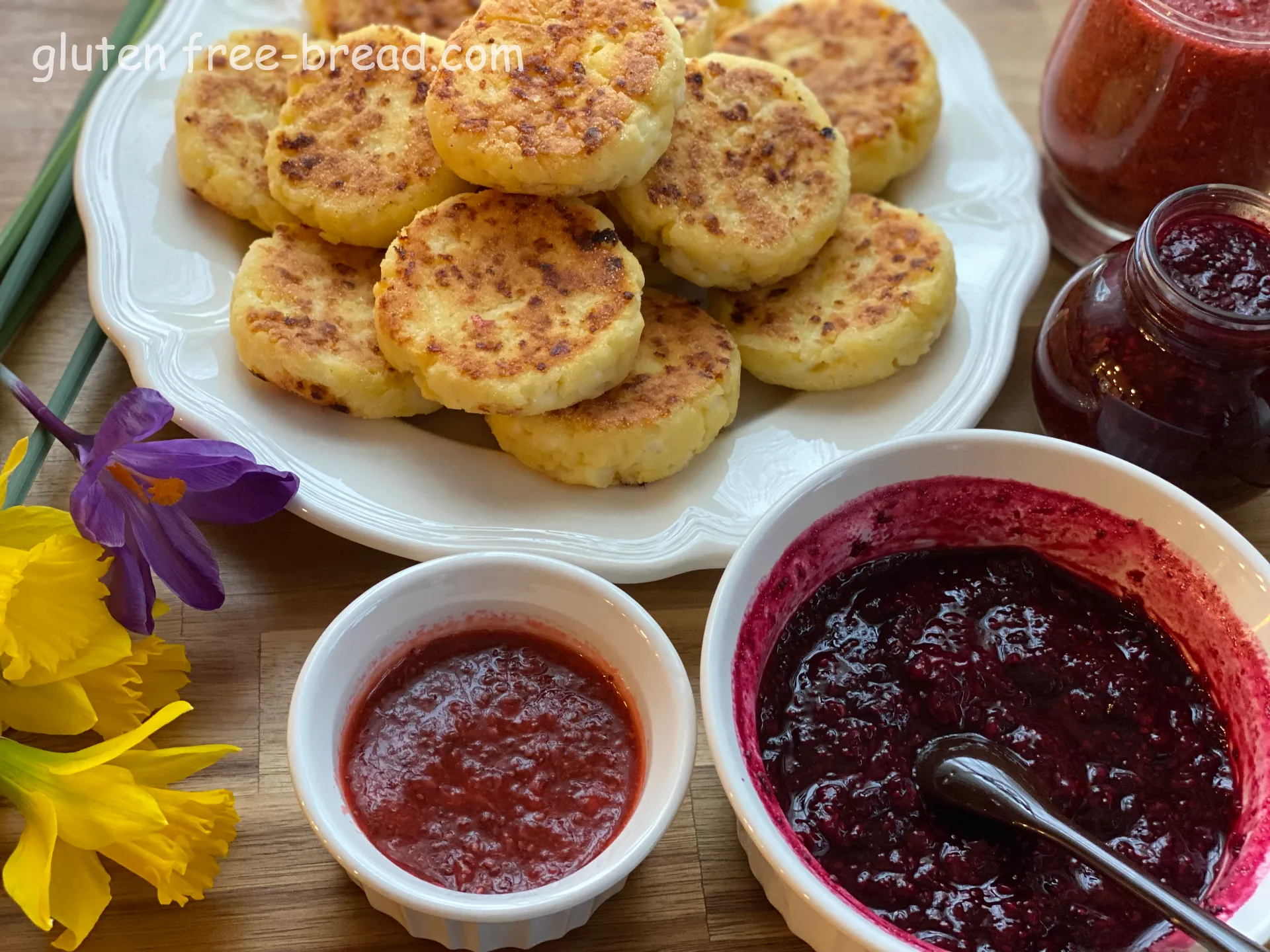
Gluten Free, Low Carbs, Oil Free, Yeast Free, Nut Free
Ingredients:
| Name | Metric | US | TIP | |
|---|---|---|---|---|
| Cottage Cheese / Farmer’s Cheese | 500 gr | 2 cups | ||
| Rice Flour or Corn Flour, divided | 150 gr | 1 cup | ||
| Eggs | 2 | 2 | ||
| Salt | 3 gr | 1/2 teaspoon | ||
| Vegetable Oil, for frying | 30 ml | 2 tbsp |
Optional Ingredients for sweet version:
| 5 ml/ 1 tsp Vanilla | |
| 50 gr / 1/4 cup Coconut Sugar | |
| 3 gr / ½ teaspoon Cinnamon | |
| 70 gr / ½ cup Raisins |
Equipment:
| Blender, food processor, or immersion blender, optional (read comments) |
Steps:
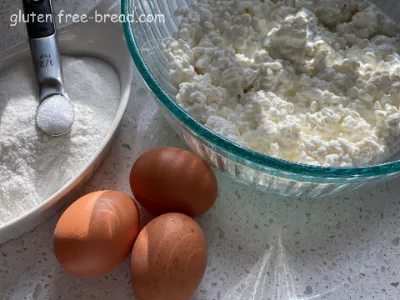
Drain the cottage cheese as well as you can in a strainer or a colander. Drain the cottage cheese as well as you can in a strainer or a colander.

In a medium bowl combine cottage cheese (2 cups), eggs (2), salt (1 teaspoon) and rice / corn flour (1 cup). The dough should be sticky but not runny. Add some more flour if it’s too runny. Set aside for 10-15 minutes. In a medium bowl combine cottage cheese (2 cups), eggs (2), salt (1 teaspoon) and rice / corn flour (1 cup). The dough should be sticky but not runny. Add some more flour if it’s too runny. Set aside for 10-15 minutes.
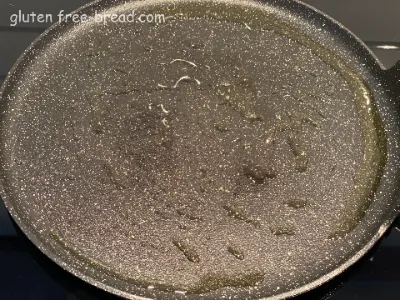
Heat a frying pan over medium heat, adding a thin layer of oil. Heat a frying pan over medium heat, adding a thin layer of oil.
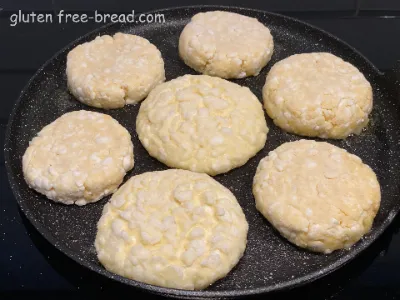
In a bowl add some corn flour (½ cup ). Scoop a ¼ cup of cottage cheese batter and roll it in flour and shape a ball. With floured hands, tap the ball gently to remove any excess flour. Flatten them to shape into patties 1-inch thick. In a bowl add some corn flour (½ cup ). Scoop a ¼ cup of cottage cheese batter and roll it in flour and shape a ball. With floured hands, tap the ball gently to remove any excess flour. Flatten them to shape into patties 1-inch thick.
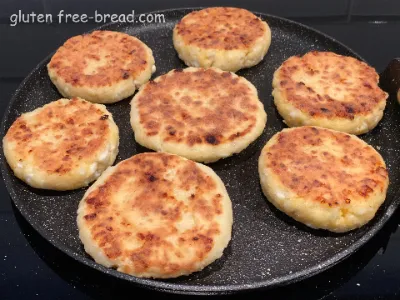
Fry both sides on low-medium heat until golden brown crust for about 3-4 minutes each side. Place on paper towels to remove excess oil. Fry both sides on low-medium heat until golden brown crust for about 3-4 minutes each side. Place on paper towels to remove excess oil.
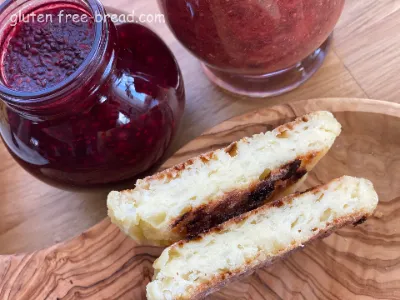
Serve with Sour Cream and Garlic Dip or yogurt, maple syrup or honey, any of your favorite jam (Chia Seed Jam with Frozen Fruit / Chia Seed Jam with Fresh Fruit). Enjoy! Serve with Sour Cream and Garlic Dip or yogurt, maple syrup or honey, any of your favorite jam (Chia Seed Jam with Frozen Fruit / Chia Seed Jam with Fresh Fruit). Enjoy!
Comments:

Cottage Cheese Mini Pancakes
When cooking Cottage Cheese Mini Pancakes, here are some tips to help you achieve delicious results:
Use Good Quality Cottage Cheese (Quark or Farmer's Cheese): The quality and moisture content of the cottage cheese will affect the texture of your Cottage Cheese Mini Pancakes. Choose a fresh and creamy cottage cheese for the best results.
Drain Excess Moisture: If your cottage cheese is very moist, drain it using cheesecloth or a fine mesh sieve to remove excess liquid. This helps prevent the Cottage Cheese Mini Pancakes from becoming too wet and difficult to handle.
Add Binders: Mix in enough flour and eggs to bind the mixture together without making it too dry. This ensures the Cottage Cheese Mini Pancakes hold their shape while frying.
Let the Mixture Rest: Allow the Cottage Cheese Mini Pancakes mixture to rest for about 15-20 minutes after combining all the ingredients. This allows the flour to hydrate and helps the mixture hold together better when frying.
Shape Carefully: Use wet hands to shape the Cottage Cheese Mini Pancakes into small patties or rounds. This prevents the mixture from sticking to your hands and helps create smooth, even shapes.
Fry Over Medium Heat: Heat a non-stick or well-greased skillet over medium heat. Cook the Cottage Cheese Mini Pancakes in batches, giving them enough space in the skillet to flip easily.
Flip Gently: Fry each side until golden brown and crispy, about 3-4 minutes per side. Use a spatula to flip them gently to avoid breaking them apart.
Serve Warm: Cottage Cheese Mini Pancakes are best served warm, immediately after frying. They can be enjoyed plain or topped with sour cream, jam, honey, or fresh berries for a delightful treat.
By following these tips, you'll be able to cook Cottage Cheese Mini Pancakes that are crispy on the outside, fluffy on the inside, and bursting with the delicious flavors of cottage cheese. Enjoy them as a delightful breakfast or dessert option!
Cottage Cheese Mini Pancakes additional information:
Cottage Cheese Mini Pancakes, also called sirniki are a traditional Russian and Ukrainian dish that has a rich history tied to Eastern European culinary traditions. These small, round pancakes or fritters are made primarily from tvorog (quark or farmer's cheese), mixed with flour, eggs, and sugar. They are typically fried and enjoyed hot, often served with sour cream, jam, honey, or fresh berries.
The history of sirniki dates back to ancient times when they were prepared as a way to use up leftover tvorog and other ingredients. Over the centuries, they have evolved into a beloved breakfast or dessert item, enjoyed by families across Russia and Ukraine. Sirniki are cherished for their fluffy texture and slightly tangy flavor from the tvorog, making them a comforting and nostalgic treat in Slavic cuisine.
Today, Cottage Cheese Mini Pancakes remain a popular dish in many households and are also served in cafes and restaurants throughout Eastern Europe. They represent a delicious example of how simple ingredients can come together to create a dish that holds cultural significance and continues to be cherished for its taste and tradition.
Cottage cheese is a nutritious dairy product that offers several health benefits. Here's a general overview of its nutritional value per 100 grams (approximately 1/2 cup) of full-fat cottage cheese:
High Protein Content: Cottage cheese is rich in protein, which is essential for muscle repair, growth, and overall body maintenance. It is particularly beneficial for those looking to increase protein intake without consuming a lot of calories.
Rich in Essential Nutrients: It contains important nutrients such as calcium, phosphorus, selenium, vitamin B12, riboflavin (vitamin B2), and various minerals. These nutrients are crucial for bone health, metabolism, and overall well-being.
Low in Calories (depending on the fat content): Cottage cheese can be relatively low in calories, especially when opting for low-fat or fat-free varieties. This makes it a suitable option for individuals watching their calorie intake.
Versatility: Cottage cheese is versatile in cooking and meal preparation. It can be enjoyed plain or mixed with fruits, vegetables, herbs, or seasonings. It can be used as a spread, added to salads, incorporated into smoothies, or used as a base for dips and sauces.
Digestibility: Cottage cheese is generally easy to digest for most people, making it a suitable choice for those with sensitive digestive systems or lactose intolerance (although individuals with lactose intolerance should choose lactose-free cottage cheese).
Source of Healthy Fats: Cottage cheese contains some healthy fats, particularly in full-fat varieties, which can help keep you feeling satisfied and provide essential fatty acids.
Probiotic Properties (in some varieties): Certain types of cottage cheese may contain live and active cultures, providing beneficial probiotics that support gut health and digestion.
Curding: Milk, usually cow's milk, is heated and then an acidifying agent such as rennet, lemon juice, or vinegar is added. This causes the milk to curdle, separating into solid curds (casein protein) and liquid whey.
Straining: The curds and whey are then separated. The curds are larger and solidify into chunks, while the whey remains as a liquid.
Cooking (optional): Some recipes may involve cooking the curds further to achieve a firmer texture and enhance flavor.
Draining: The curds are drained of excess whey using a fine mesh sieve or cheesecloth. The duration of draining determines the moisture content of the final product; longer draining results in drier cottage cheese.
Packaging: Once drained to the desired consistency, the cottage cheese may be further processed (such as adding cream or salt) and packaged for sale.
Regular Cottage Cheese: This is the standard variety, typically made from whole milk. It has a creamy texture and is rich in flavor due to its higher fat content.
Low-Fat or Reduced-Fat Cottage Cheese: Made from skimmed or reduced-fat milk, this variety has less fat and fewer calories compared to regular cottage cheese. It maintains a similar texture but may be slightly less creamy.
Fat-Free or Non-Fat Cottage Cheese: This type is made from skim milk and has little to no fat content. It is the lowest in calories among cottage cheese varieties and has a lighter texture.
Large-Curd Cottage Cheese: This variety has larger curds, giving it a chunkier texture compared to small-curd cottage cheese. It tends to be creamier and richer in taste.
Small-Curd Cottage Cheese: Small-curd cottage cheese has smaller, finer curds, resulting in a smoother texture. It is often preferred for recipes where a smoother consistency is desired, such as dips or spreads.
Creamed Cottage Cheese: Creamed cottage cheese is blended with cream or additional milk, resulting in a richer and creamier texture. It is often used as a spread or topping.
Salted or Unsalted: Cottage cheese can come in salted or unsalted varieties. Salted cottage cheese has added salt for flavor, while unsalted varieties have a milder taste and are suitable for those watching their sodium intake.
Tofu-based Cottage Cheese: Tofu is often used as a base for vegan cottage cheese. Silken tofu or firm tofu can be blended or crumbled to achieve a texture similar to cottage cheese. Lemon juice, nutritional yeast, and seasonings are often added for flavor.
Cashew-based Cottage Cheese: Cashews are soaked and blended with water or plant-based milk to create a creamy texture. Nutritional yeast, lemon juice, and salt are commonly added to mimic the tangy flavor of traditional cottage cheese.
Almond-based Cottage Cheese: Almonds can also be soaked and blended to create a creamy base for vegan cottage cheese. Similar to cashew-based versions, nutritional yeast, lemon juice, and seasonings are used to enhance flavor.
Soy-based Cottage Cheese: Some commercial brands offer soy-based cottage cheese alternatives made from soy milk or soy protein. These may have a texture and flavor profile similar to dairy cottage cheese.
Coconut-based Cottage Cheese: Coconut milk or coconut cream can be used to create a rich and creamy vegan cottage cheese. It may have a slightly sweet coconut flavor, which can be complemented with savory seasonings.
Cottage cheese has several properties that make it a popular and nutritious food choice:
Overall, cottage cheese is valued not only for its nutritional content but also for its versatility and ease of incorporation into various diets and culinary preparations.
Cottage cheese is obtained through a relatively simple process involving the separation of curds from whey in milk. Here's how it is typically obtained:
Depending on the desired fat content, cottage cheese may be made from whole milk, reduced-fat milk, or skim milk. Varieties with higher fat content are typically creamier and richer in flavor.
The process of making cottage cheese is similar to that of other fresh cheeses and has been practiced for centuries, making it a staple in many cultures around the world.
Cottage cheese comes in several varieties based on the milk fat content and curd size. Here are the common types:
These variations cater to different dietary preferences and nutritional needs, offering options for those looking to reduce fat or calorie intake while still enjoying the protein and other nutritional benefits of cottage cheese.
There are vegan alternatives to traditional dairy-based cottage cheese. These vegan versions are made using plant-based ingredients instead of milk. Here are some common options:
Vegan cottage cheese alternatives are suitable for individuals who follow a vegan diet or are lactose intolerant. They can be used in similar ways to traditional cottage cheese, such as in salads, dips, spreads, or eaten plain with fruits or vegetables. These options provide a plant-based source of protein and can be a nutritious addition to meals and snacks.